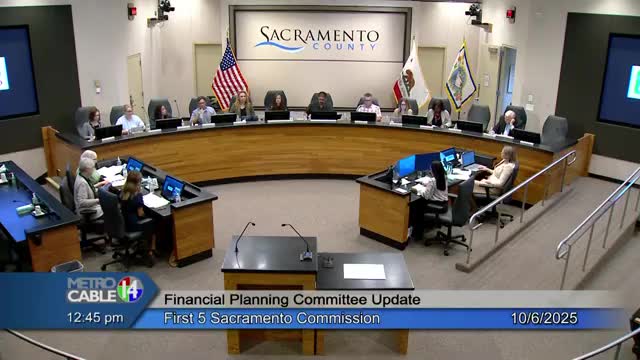First 5 Sacramento approves high-level 2027–2030 spending plan amid projected Prop 10 revenue decline
October 20, 2025 | Sacramento County, California
This article was created by AI summarizing key points discussed. AI makes mistakes, so for full details and context, please refer to the video of the full meeting. Please report any errors so we can fix them. Report an error »

The First 5 Sacramento Commission on Oct. 6 voted to approve a high-level spending plan for its 2027–2030 implementation period that envisions $11,900,000 in annual spending and $35,700,000 over three years.
Lindsay Dunkel, First 5 strategic planning lead, told the commission the plan reflects a roughly 20% reduction from the current plan "about a 20% reduction" driven principally by declining Proposition 10 revenue and a lower county birth rate. Dunkel said staff used unspent prior-year funds and new external leverage to reduce a larger projected drop and that the proposed baseline assumes only core revenues (Prop 10, MA dollars, interest and other stable funding), excluding pass-through program-specific dollars such as CalWORKs home visiting.
The plan directs the majority of funding to programs and services: Dunkel said 84% of the proposed spending is for program delivery, 11% for administration and 5% for evaluation. She told commissioners the program amount of roughly $29,900,000 includes both internal program costs (about 17% of program funding for staff, media and systems work) and external contracts with community partners (about 82.5% of program funds).
Commissioners raised questions about data and how staff would use community input to prioritize among themes. Dunkel said staff held six community conversations (including groups for Afghan parents, fathers, people experiencing homelessness and a Spanish-language group) and described recurring themes: family stability and access to supports, healthy lifestyle and developmental screenings, parent learning and supports for families with children with developmental challenges, community connection, communication/navigation of services, quality culturally responsive providers and job and career pathways for early childhood providers. She said community participants represented 20 ZIP codes, included parents of children with special needs and that staff will return to community members to rank proposed strategies.
Dunkel also described a county trends tool produced by Applied Survey Research that will be used alongside community voice; she told the commission the tool contains county trends, state comparisons and disparity rates and that some indicators have more recent data than others.
The commission approved the high-level spending plan by roll call. The vote followed staff’s presentation and the commission’s discussion of next steps for allocating dollars through a community-informed process.
Looking ahead, Dunkel said staff will develop detailed allocations through collaboration with community and commissioners, and that funding decisions are on track so that a funding process could launch in 2026 with contracts starting July 1, 2027.
Lindsay Dunkel, First 5 strategic planning lead, told the commission the plan reflects a roughly 20% reduction from the current plan "about a 20% reduction" driven principally by declining Proposition 10 revenue and a lower county birth rate. Dunkel said staff used unspent prior-year funds and new external leverage to reduce a larger projected drop and that the proposed baseline assumes only core revenues (Prop 10, MA dollars, interest and other stable funding), excluding pass-through program-specific dollars such as CalWORKs home visiting.
The plan directs the majority of funding to programs and services: Dunkel said 84% of the proposed spending is for program delivery, 11% for administration and 5% for evaluation. She told commissioners the program amount of roughly $29,900,000 includes both internal program costs (about 17% of program funding for staff, media and systems work) and external contracts with community partners (about 82.5% of program funds).
Commissioners raised questions about data and how staff would use community input to prioritize among themes. Dunkel said staff held six community conversations (including groups for Afghan parents, fathers, people experiencing homelessness and a Spanish-language group) and described recurring themes: family stability and access to supports, healthy lifestyle and developmental screenings, parent learning and supports for families with children with developmental challenges, community connection, communication/navigation of services, quality culturally responsive providers and job and career pathways for early childhood providers. She said community participants represented 20 ZIP codes, included parents of children with special needs and that staff will return to community members to rank proposed strategies.
Dunkel also described a county trends tool produced by Applied Survey Research that will be used alongside community voice; she told the commission the tool contains county trends, state comparisons and disparity rates and that some indicators have more recent data than others.
The commission approved the high-level spending plan by roll call. The vote followed staff’s presentation and the commission’s discussion of next steps for allocating dollars through a community-informed process.
Looking ahead, Dunkel said staff will develop detailed allocations through collaboration with community and commissioners, and that funding decisions are on track so that a funding process could launch in 2026 with contracts starting July 1, 2027.
Don't Miss a Word: See the Full Meeting!
Go beyond summaries. Unlock every video, transcript, and key insight with a Founder Membership.
✓
Get instant access to full meeting videos
✓
Search and clip any phrase from complete transcripts
✓
Receive AI-powered summaries & custom alerts
✓
Enjoy lifetime, unrestricted access to government data
30-day money-back guarantee

